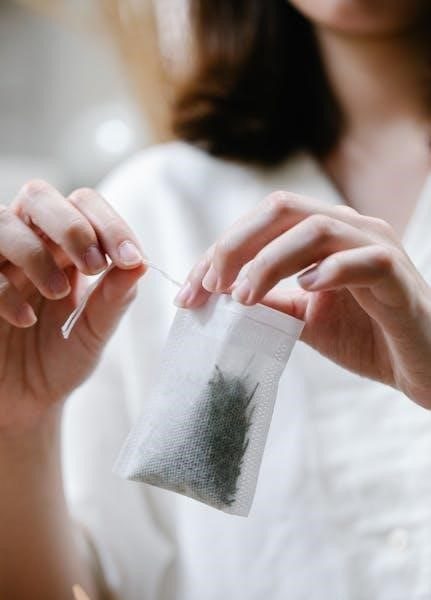
tea brewing guide
Discover the art of brewing tea with our comprehensive guide, covering essential techniques, tools, and tips for perfecting your cup. From water quality to steeping times, unlock the flavors of black, green, white, and herbal teas with ease and precision, ensuring every sip is delightful and satisfying.
The Importance of Proper Brewing Techniques
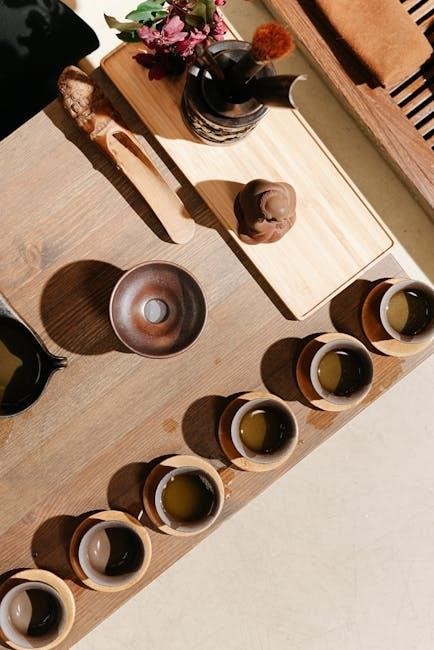
Proper brewing techniques are essential for extracting the optimal flavor and aroma from tea leaves. Using the right water temperature, steeping time, and tea-to-water ratio ensures a balanced and enjoyable cup. Over-steeping can lead to bitterness, while under-steeping may result in a weak brew. Clean, fresh water is crucial, as impurities can alter the taste. Understanding these fundamentals allows you to bring out the unique characteristics of each tea type, whether it’s the delicate notes of green tea or the robust flavors of black tea. Mastering these techniques also helps avoid common mistakes, ensuring consistency and enhancing your overall tea-drinking experience. By paying attention to these details, you can elevate your brew and fully appreciate the art of tea-making.
Brief History of Tea Brewing
Tea brewing has a rich history that dates back thousands of years, originating in China around 2700 BCE. According to legend, Emperor Shennong discovered tea when leaves fell into boiling water, creating a refreshing and energizing drink. Over time, tea became deeply embedded in Chinese culture, used for medicinal purposes, rituals, and everyday enjoyment. During the Tang Dynasty, tea production and brewing techniques flourished, spreading to neighboring regions like Japan. In Japan, tea ceremonies evolved, emphasizing mindfulness and artistry. Tea later reached Europe through trade routes, becoming a staple in British culture and leading to the tradition of afternoon tea. Today, tea brewing remains a cherished practice worldwide, with techniques influenced by its ancient origins and adapted to modern tastes.
Understanding Tea Types
Understanding Tea Types explores the diversity of teas, from black to herbal, each with unique flavors, processing methods, and caffeine levels, offering something for every palate.
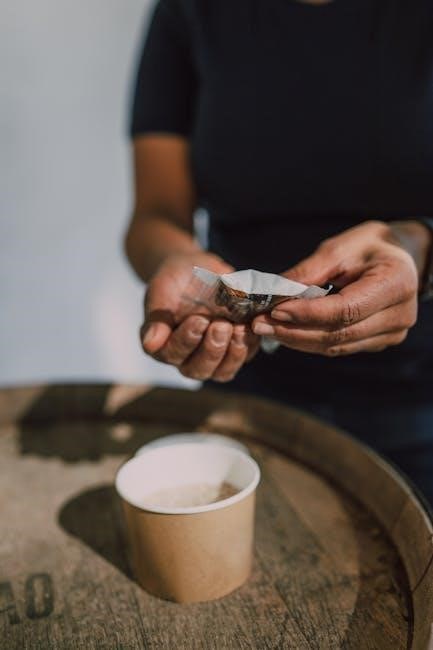
Black Tea
Black tea is one of the most popular tea types, known for its robust flavor and dark color. It is fully oxidized, which enhances its bold, earthy, and slightly sweet notes. Originating in China, black tea is now grown worldwide, with famous varieties like Assam, Darjeeling, and Ceylon. The leaves are withered, rolled, oxidized, and fired, giving them their distinctive taste. Black tea pairs well with milk and sugar, making it a favorite for breakfast blends. Its higher caffeine content provides a energizing brew. For optimal flavor, black tea is typically steeped in boiling water for 3–5 minutes. Experimenting with steeping times can tailor the strength to your preference, ensuring a satisfying and rich cup every time. Whether enjoyed hot or iced, black tea offers versatility and depth for tea enthusiasts.
Green Tea
Green tea is renowned for its light, refreshing flavor and numerous health benefits. It is minimally oxidized, preserving its natural antioxidants and delicate taste. Originating in China, green tea is now cultivated in countries like Japan and India, with popular varieties such as Sencha, Dragonwell, and Matcha. The leaves are harvested, withered, and quickly heated to halt oxidation, resulting in their vibrant green color and grassy or vegetal notes. Green tea is best brewed with water at 160°F to 170°F (71°C to 77°C) for 1 to 3 minutes, depending on the variety. Over-steeping can lead to bitterness, so precision is key. Green tea is often enjoyed plain to appreciate its subtle nuances, though some prefer it with a squeeze of lemon. Its light, refreshing profile makes it an excellent choice for those seeking a soothing and revitalizing brew.
White Tea
White tea is the least processed and most delicate of all teas, made from the young buds of the tea plant, often covered in fine, silvery-white hairs. It is primarily produced in China, particularly in Fujian Province, with popular varieties like Silver Needle and White Peony; White tea is known for its light, floral, and slightly sweet flavor profile, with hints of honey and melon. To brew white tea, use water at 150°F to 160°F (65°C to 71°C) and steep for 2 to 5 minutes, depending on the variety. Over-steeping can lead to bitterness, so careful timing is essential. Its delicate nature makes it best enjoyed without additives, allowing its subtle nuances to shine. White tea is also rich in antioxidants and is often praised for its potential health benefits, making it a popular choice for those seeking a light, refreshing brew.
Oolong Tea
Oolong tea is a partially fermented tea that offers a unique flavor profile, bridging the gap between green and black teas. Originating from Taiwan, oolong teas are known for their complex taste, which can range from floral and fruity to nutty and honey-like. The fermentation process varies, with some oolongs being more green-like (less fermented) and others closer to black tea (more fermented). To brew oolong tea, use water at 180°F to 200°F (82°C to 93°C) and steep for 3 to 5 minutes. Many oolong teas can be infused multiple times, with each infusion revealing different layers of flavor. The ideal brewing technique often involves a gongfu-style setup, emphasizing small teapots and short steeping times to preserve the tea’s delicate characteristics. Oolong tea is also celebrated for its potential health benefits, including aiding digestion and boosting metabolism.
Herbal Tea
Herbal tea, also known as tisane, is not made from tea leaves but from the infusion of herbs, fruits, flowers, and spices. It is naturally caffeine-free, making it a popular choice for those seeking a soothing, non-stimulating beverage. Popular herbal teas include chamomile, peppermint, hibiscus, and rosehip. To brew herbal tea, use boiling water (212°F or 100°C) and steep for 5 to 7 minutes, depending on the ingredients. Unlike true teas, herbal teas can often be steeped longer without becoming bitter, as they lack tannins. They can be enjoyed hot or iced and are often enhanced with honey or lemon. Herbal teas are prized for their potential health benefits, such as aiding digestion, promoting relaxation, or providing vitamins. Their versatility and calming properties make them a delightful addition to any tea-brewing routine.
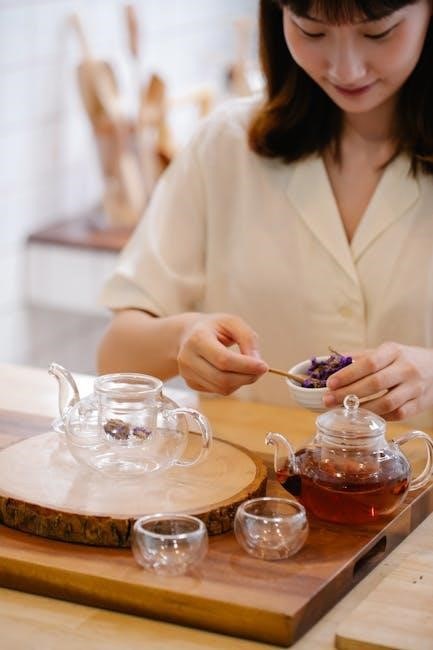
Essential Tools and Equipment
Essential tools for brewing include teapots, kettles, tea infusers, strainers, measuring spoons, mugs, and a tea cozy for maintaining warmth during steeping.
Teapots and Infusers
Teapots and infusers are fundamental tools for brewing tea. Teapots come in various materials, such as ceramic, glass, or porcelain, each offering unique benefits. Ceramic teapots are ideal for retaining heat, while glass ones allow for visual monitoring of the infusion process. Infusers, whether built-in or separate, enable loose-leaf tea to unfurl evenly, releasing flavors and aromas. Stainless steel, silicone, or mesh infusers are popular choices for their durability and ease of cleaning. When selecting a teapot, consider its size and shape, as these can influence the brewing experience. A teapot with a built-in strainer or a separate infuser is perfect for loose-leaf teas, ensuring a smooth and mess-free process. Proper care, including regular cleaning, is essential to maintain the quality of your brew and the longevity of your equipment. Investing in high-quality teapots and infusers enhances both the taste and enjoyment of your tea.
Kettles for Heating Water
Kettles play a crucial role in tea brewing by providing the precise water temperature needed for different teas. Stovetop kettles are traditional and cost-effective, while electric kettles offer speed and temperature control features. Gooseneck kettles are favored for their controlled pour, ideal for methods like pour-over. Materials vary, with stainless steel being durable and easy to clean, copper offering excellent heat conductivity but requiring maintenance, and glass allowing visibility during boiling. Kettle capacity should suit the brewing needs, whether for single servings or multiple cups. Features like automatic shut-off enhance safety and convenience. Regular maintenance, such as descaling to prevent mineral buildup, is essential for longevity. A good kettle ensures consistent water temperature, directly impacting the flavor and aroma of the tea, making it an indispensable tool in the tea brewing process.
Tea Bags vs. Loose-Leaf Tea
When it comes to tea brewing, the choice between tea bags and loose-leaf tea significantly impacts the experience. Tea bags are convenient and pre-measured, making them ideal for quick brewing. However, they often contain lower-grade tea dust, which can lack complexity and depth in flavor. Loose-leaf tea, on the other hand, offers superior quality and aroma, as it consists of whole tea leaves that unfurl during steeping. This allows for a richer, more nuanced taste. Loose-leaf also provides flexibility in portion control and steeping times. While tea bags are more accessible, loose-leaf is preferred by enthusiasts for its craftsmanship and customizable brewing. Both options cater to different preferences, but loose-leaf is often recommended for achieving the full potential of tea’s flavor profile. Each method has its benefits, making the choice dependent on personal convenience and taste priorities;
Water Quality and Temperature
Water quality and temperature play a crucial role in tea brewing.
Using fresh, filtered water ensures optimal flavor,
while the right temperature brings out the tea’s nuances.
Impurities can alter taste,
and varying temperatures suit different tea types.
The Role of Water in Brewing
Water is the foundation of tea brewing, as it directly impacts the flavor and aroma of the tea; Fresh, clean water is essential to prevent any impurities or odors from altering the taste. Using filtered or spring water is recommended, as tap water may contain minerals or chemicals that can affect the tea’s quality. Hard water, for instance, can accentuate bitterness, while soft water may result in a flatter taste. Ideally, water should be free from chlorine and heavy metals to ensure a pure extraction of the tea’s natural flavors. Additionally, the temperature of the water must align with the type of tea being brewed, as this affects how the leaves unfurl and release their compounds. Thus, understanding and selecting the right water is a cornerstone of mastering the art of tea brewing.
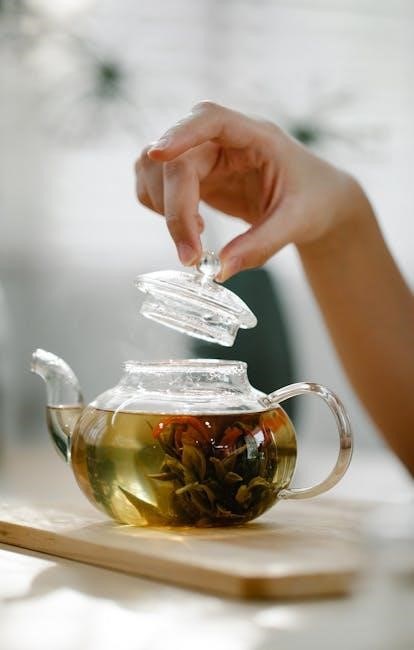
Ideal Water Temperatures for Different Teas
Different teas require specific water temperatures to bring out their unique flavors and aromas. Black tea, being robust, is best brewed with boiling water (200-212°F or 93-100°C). Green tea, on the other hand, prefers slightly cooler water (160-170°F or 71-77°C) to avoid bitterness. White tea, the most delicate, should be brewed at an even lower temperature (150-160°F or 65-71°C) to preserve its subtle notes. Oolong tea falls between green and black tea, typically requiring water at 180-200°F (82-93°C), depending on its oxidation level; Herbal teas, which are not made from tea leaves, can usually tolerate boiling water (212°F or 100°C). Using the correct temperature ensures optimal extraction and a more enjoyable drinking experience. Experimenting with these ranges can help you find your perfect cup.
Measuring Tea Leaves
Properly measuring tea leaves ensures balanced flavor. Use one teaspoon of loose-leaf tea per 8 ounces of water, adjusting for personal taste and tea type.
The Right Amount of Tea for Perfect Flavor
The right amount of tea leaves is crucial for achieving the perfect balance of flavor. A general rule of thumb is to use one teaspoon of loose-leaf tea or one tea bag for every 8 ounces of water. However, this can vary depending on the type of tea and personal preference. For example, robust teas like Assam or Ceylon may require a bit more, while delicate teas like green or white tea may need less. Overusing tea leaves can result in a bitter taste, while too few leaves may lead to a weak brew. Adjusting the amount based on the tea’s strength and your taste buds is key to a satisfying cup. Experimenting with different measurements helps find the ideal balance for your favorite brews.
Adjusting for Personal Preference
Adjusting the amount of tea leaves or steeping time allows you to tailor the flavor to your liking. Some prefer a stronger, bolder taste, while others enjoy a lighter, more delicate brew. Start with the recommended amount and gradually tweak it based on your taste buds. If you find the tea too weak, add a little more tea or extend the steeping time. Conversely, if it’s too strong, reduce the leaves or shorten the infusion. Experimenting with these variables helps you discover your perfect cup. Additionally, factors like milk, sugar, or honey can enhance the flavor, but it’s important to balance them without overpowering the tea’s natural notes. Personalizing your brew ensures a more enjoyable and satisfying tea-drinking experience.
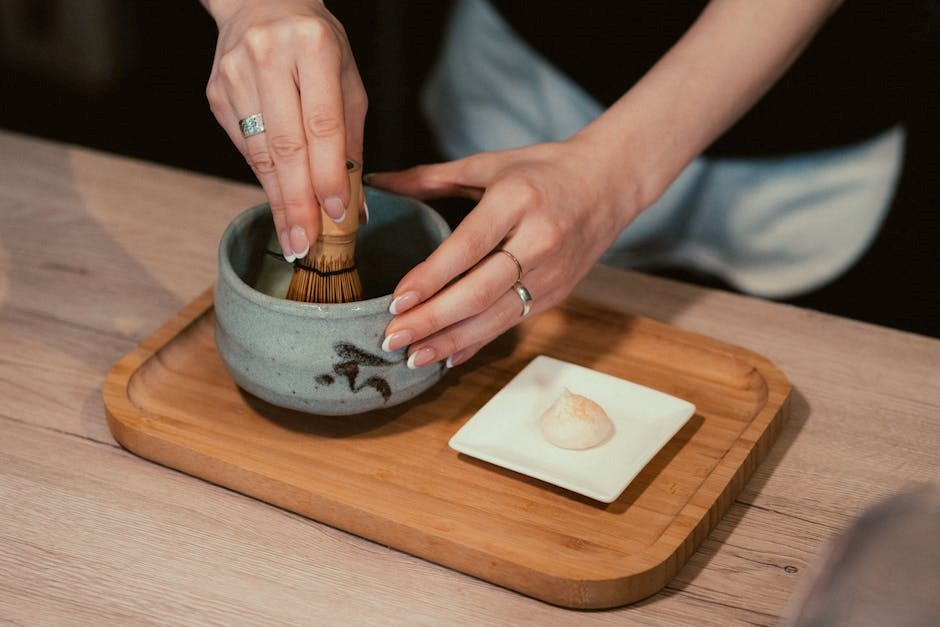
Steeping Time and Technique
Mastering steeping time and technique is crucial for optimal flavor. Factors like tea type, water temperature, and personal preference influence the perfect infusion. Adjust time to balance strength and aroma, ensuring a delightful brew.
General Steeping Guidelines
Proper steeping is essential for bringing out the best in your tea. Start with fresh, filtered water heated to the ideal temperature for your tea type. Use one teaspoon of loose-leaf tea or one tea bag for every 8 ounces of water. Pour the water over the tea leaves and let it steep. Most teas require 1 to 5 minutes, depending on the variety. Black teas typically steep longer than green or white teas. Avoid over-steeping, as it can lead to bitterness. Use a timer to ensure consistency. Once the steeping time is up, remove the leaves or tea bag to prevent over-extraction. Adjust the time based on your preference for strength and flavor. This balance ensures a perfect cup every time, whether you’re brewing a robust black tea or a delicate herbal infusion.
Specific Steeping Times for Each Tea Type
Different teas require unique steeping times to bring out their optimal flavor and aroma. Black teas generally steep for 3 to 5 minutes, allowing their robust flavors to develop fully. Green teas, being more delicate, typically require 2 to 3 minutes to prevent bitterness. White teas, with their light and subtle notes, should steep for 2 to 4 minutes. Oolong teas, which vary in oxidation levels, may need 3 to 5 minutes, depending on their complexity. Herbal teas, being caffeine-free and made from herbs, flowers, or fruits, usually steep for 5 to 7 minutes to extract their full flavor. Adjusting these times based on personal taste ensures the perfect balance of strength and flavor for every cup.
Advanced Brewing Techniques
Explore methods like multiple infusions, cold brewing, and Gongfu style to elevate your tea experience. These techniques enhance flavor and aroma for true tea enthusiasts.
Multiple Infusions
Multiple infusions involve steeping the same tea leaves more than once, a practice common with high-quality teas like oolong, pu-erh, and some green teas. Each infusion reveals different flavor profiles, with the first often being the boldest and subsequent ones smoother. Start by rinsing the leaves briefly, then steep as usual. After the first infusion, increase the steeping time slightly for the second and third infusions. This technique highlights the tea’s complexity and extends enjoyment. Proper water temperature and leaf quality are crucial for successful multiple infusions. Experimenting with infusion times and tea types can enhance the experience, making it a rewarding skill for tea enthusiasts to master.
Cold Brewing and Iced Tea
Cold brewing and iced tea offer refreshing alternatives to hot tea, perfect for warm weather. Cold brewing involves steeping tea leaves in cold water for an extended period, typically 8-12 hours, resulting in a smooth, less bitter flavor. This method is ideal for green, black, and herbal teas. Iced tea, on the other hand, can be made by chilling hot-brewed tea or using cold-brewed tea. For cold brewing, combine 1 teaspoon of loose-leaf tea (or one tea bag) per 8 oz of water in a large glass container and refrigerate. Serve over ice for a crisp, thirst-quenching drink. Experiment with fruits, herbs, or mint for added flavor. Cold brewing and iced tea are versatile and easy to prepare, making them great for any occasion.
Gongfu Style Brewing
Gongfu style brewing is a traditional Chinese method emphasizing precision and mindfulness. Originating in Fujian Province, it involves using small teapots, typically made of Yixing clay, to brew oolong, pu-erh, or other robust teas. The process highlights the quality of tea leaves and water, with a focus on multiple short infusions. Start by rinsing the leaves, then steep for 10-30 seconds, increasing time slightly with each infusion. Serve in small cups to appreciate the tea’s complexity. Gongfu brewing is as much about the ritual as the flavor, fostering a meditative connection between the brewer and the tea. This method is ideal for tea enthusiasts seeking a deeper, more immersive experience.
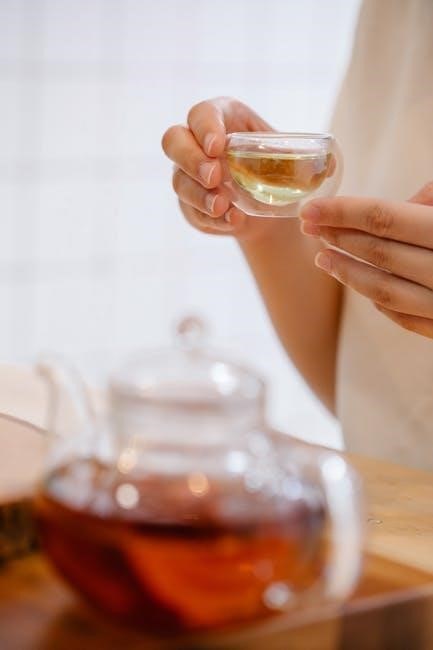
Common Mistakes to Avoid
Over-steeping, using boiling water, and ignoring tea-to-water ratios are common errors. Adjusting techniques ensures balanced flavors and prevents bitterness for a perfect brew every time.
Over-Steeping and Bitterness
Over-steeping is a common mistake that leads to bitterness in tea. Leaving tea leaves in hot water for too long releases excessive tannins, resulting in an unpleasantly bitter flavor. To avoid this, use a timer to monitor steeping time, especially for delicate teas like green tea, which typically require 1-3 minutes. Black teas can steep longer, around 3-5 minutes, but exceeding this can ruin the balance. Adjust steeping times based on personal taste, as some teas, like white tea, are best with shorter infusions. Using high-quality tea leaves also helps minimize bitterness, as they release flavors more evenly. Over-steeping can make the tea undrinkable without additives, so mindfulness during brewing ensures a smooth, enjoyable flavor profile.
Using the Wrong Water Temperature
Using the wrong water temperature is a common mistake that can significantly affect the flavor and aroma of tea. For example, boiling water can scorch delicate teas like green or white tea, leading to bitterness, while water that’s too cool may fail to extract the full flavor of robust teas like black tea. Each tea type has an ideal temperature range: green tea typically requires water between 160°F and 170°F, while black tea thrives at boiling point (212°F). Using a thermometer can help achieve precise control. Overheating or underheating water disrupts the balance of flavors and aromas, making the tea taste flat or overly harsh. Adjusting water temperature according to the tea type ensures a more enjoyable and authentic brewing experience, preserving the tea’s natural characteristics and complexity.
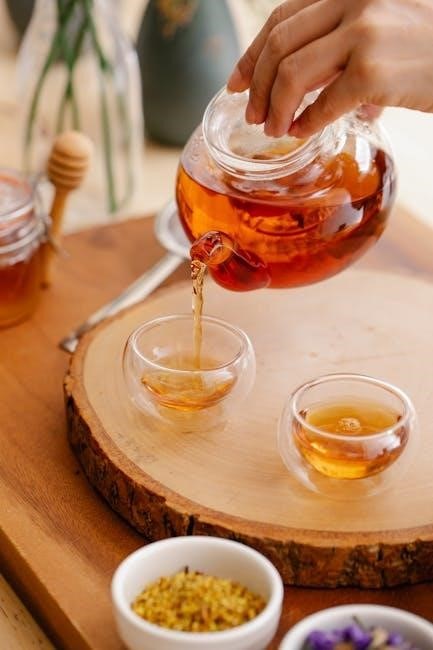
Enhancing Your Brew
Discover how to elevate your tea experience by exploring additives, sweeteners, and accessories that complement your brew, tailoring it to your unique preferences for a richer, more enjoyable cup.
Adding Milk and Sweeteners
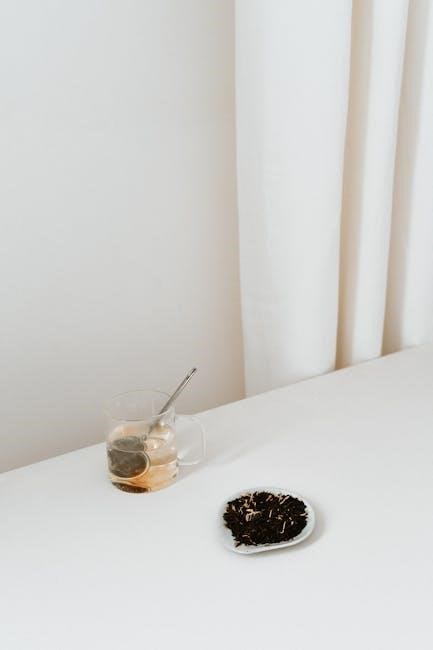
Enhance your tea experience by incorporating milk and sweeteners to balance flavors and create a personalized taste. For dairy lovers, whole milk or cream adds richness, while plant-based options like almond or oat milk offer a dairy-free alternative. Sugar, honey, and agave syrup are popular sweeteners that complement tea’s natural notes. For a lighter touch, try stevia or monk fruit sweetener. When adding milk, pour it during or after steeping, depending on the tea type—black teas like Earl Grey pair well with milk, while green teas are often enjoyed plain. Sweeteners should be added sparingly to avoid overpowering the tea’s delicate flavors. Experiment with ratios and timing to find your perfect blend, ensuring each sip reflects your unique preference.
Using Tea Accessories and Garnishes
Elevate your tea experience with the right accessories and creative garnishes. Tea accessories like infusers, strainers, and tea balls simplify loose-leaf brewing, while coasters and tea caddies add elegance to your setup. Garnishes such as lemon slices, mint leaves, or edible flowers like rose petals or lavender can enhance both flavor and visual appeal. For instance, a lemon wedge complements herbal teas, while fresh mint brightens green tea. Edible flowers add a delicate, floral note and a decorative touch. Experiment with these elements to create a personalized and visually appealing tea ritual. Whether you’re hosting guests or savoring a moment alone, thoughtful use of accessories and garnishes can transform your brew into a memorable experience.
Related Posts

national audubon field guide to mushrooms
Unlock the fascinating world of mushrooms! Audubon’s guide makes identification easy & fun. Explore detailed descriptions & stunning photos. Your **mushroom** journey starts here!

being a dik season 2 guide
Dive into the world of “Being a Dik” with our comprehensive Season 2 guide. Get episode breakdowns, key highlights, and insider tips. Your ultimate resource for the latest season!

tv guide delray beach
Discover what’s on TV tonight in Delray Beach. Your complete guide to local channels, shows, and listings. Find your favorite channels now!